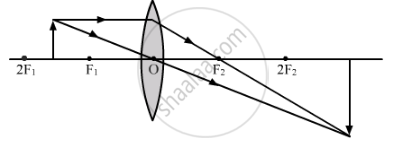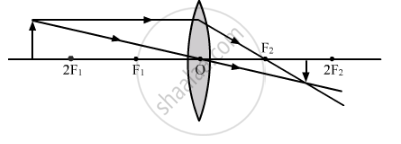Advertisements
Advertisements
प्रश्न
A student wants to project the image of a candle flame on the walls of school laboratory by using a lens:-
(a) Which type of lens should be use and why?
(b) At what distance in terms of focal length 'F' of the lens should be place the candle flame so as to get (i) a magnified, and (ii) a diminished image respectively on the wall?
(c) Draw ray diagram to show the formation of the image in each case?
उत्तर
(a) He should use a convex lens as it forms real images.
(b) He should place the candle flame between F and 2F (the focus and centre of curvature of the lens) to get the magnified image on the wall while the diminished image is obtained when the object is located at a distance greater than 2F.
(c) The ray diagram for the formation of the magnified image is shown below:

The ray diagram for the formation of the diminished image is shown below:

संबंधित प्रश्न
Draw a ray diagram to show the formation of image in the above situation
"A lens can form a magnified erect image as well as magnified inverted image of an object placed in front of it." State the nature of this lens and draw ray diagrams to justify the above statement. Mark the positions of O, F and 2F in the diagram.
Draw a labelled ray diagram to show the angle of incidence and the angle of refraction for a refracted ray of light.
Explain with the help of a diagram, why the convex lens is also called a converging lens.
An object 2 cm tall is placed on the axis of a convex lens of focal length 5 cm at a distance of 10 m from the optical centre of the lens. Find the nature, position and size of the image formed. Which case of image formation by convex lenses is illustrated by this example?
If the object is moved to a point only 3 cm away from the lens, what is the new position, height and nature of the image?

i. Which type of microscope has the arrangement of lenses shown in the adjoining figure?
ii. Label the figure correctly.
iii. Write the working of this microscope.
iv. Where does this microscope used?
v. Suggest a way to increase the efficiency of this microscope.
In sunglasses, both of its surfaces are curved, yet their behaviour is neither like a convex lens nor like a concave lens. State the reason.
For a specific glass lens f = 0.5 m. This is the only information given to the student. Which type of lens is given to him and what is its power?
_______ times larger images can be obtained by using a simple microscope.
